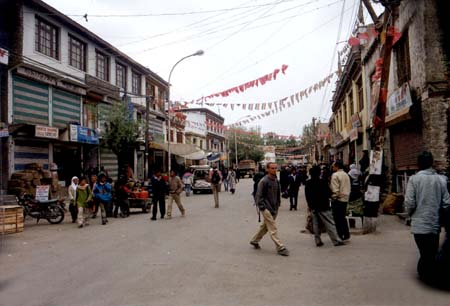The Indian Airlines flight from Delhi to Leh was uneventful. It was raining in Delhi, and a lot cooler than it usually is, as if helping us acclimatize to the cooler areas we were headed to. The flight was delayed by a few hours, and we finally landed at Ladakh around noon. As we stepped out of the plane and waited for the bus to take us to the terminal, we were awestruck by the landscape that greeted us. We were surprised to see such a wide valley at that altitude - 11,400 feet. All around, snow-covered mountain peaks surrounded us, with Indus River flowing alongside the runway, allowing a small patch of greenery in the otherwise barren land. We did a one-kilometer trek to the Army Transit Camp, where we managed to get two rooms through some Army contacts. The transit camp is 3-4kms from the Leh City, and after settling down, we were lucky to get a ride to the city in a army Jonga.
Leh, the capital city of the region, is dominated by the Sengge Namgyal's nine-story palace, a building in the grand tradition of Tibetan architecture. Above it, on Namgyal Tsemo, the peak overlooking the town, are the ruins of the earliest royal residence at Leh, a fort built by King Tashi Namgyal in the 16th century. The associated temples remain intact, but they are kept locked except during the morning and evening hours when a monk toils up the hills from Sankar Gompa to attend to the butter lamps in front of the images. A small trail starting from the main market leads to the Namgyal's palace. We labored up the trail for about half an hour, only to find that the palace was closed for the day. But the view of Leh City from the top of the hill was worth the effort.
 |
Down in the bazar, the main sites to visit are the Jo-khang, a modern ecumenical Budhist temple, and the imposing mosque dating 17th century almost opposite. For locals and visitors alike, a stroll along the main bazar, observing the varied crowd and peering into the curio shops is an entrancing experience. A particularly charming site is the line of women from the nearby villages sitting along the edge of the footpath with baskets of fresh vegetables brought for sale to the townspeople. Chang Gali, behind the main bazar, is less bustling but has intriguing little shops selling curios and jewelry, and further on are the labyrinthine alleyways and piled-up houses of the old city, clustering around the foot of the palace hill. In the other direction, down from the bazar, is the Moti Market, stalls of Tibetan traders where you can bargain for pearls, turquoise, and other kinds of semi-precious stones and jewelry. When you are tired of strolling, you can step into any of the German bakeries or several restaurants, which serve local, Tibetan, Indian and Continental cuisine. Another recommended place for having snacks is “Neha Snacks” a small shop on the main road, which serves excellent “bread-pakoras” and “samosas”. |
| Our plan was to move on to Pangong Tso Lake the next day. The only way to go there is by a taxi, and costs around Rs 5000. In addition, a permit has to be obtained from the DM's office, as it is a sensitive border area. But the second day turned out to be a disappointment - it started raining heavily. Rain? In a desert? Yes. Ladakh has clear blue skies for 300 days in a year, and on the remaining days, it generally snows. But with increasing green cover due to cultivation of land, rains have started frequenting this area. So, the second day found us still in the vicinity of Leh, and we killed time by visiting the modern Ladakh Shanti Stupa. It stands on top of a hill above the village of Changspa, practically a suburb of Leh. The stupa can be reached by stairs, or by following a long winding road. We took the stairs, and about halfway it started raining lightly which turned into a snow flurry by the time we reached the stupa! The stupa provides a commanding view of the entire Leh City, and also a glimpse of the road that takes one to Khardung La Pass. |
Copyright (c) Manish Tripathi , 1998. All rights reserved